(lire la version française en cliquant sur le drapeau tricolore)
[ last update: 03.14.2014 ]
The (new)
Cadillac Database©
The Cadillac Eldorado Brougham
1957 - 1960
Part 4
Brougham for the Brass
Being some reflections on the special
Eldorado Brougham Town Car of 1956
Return to The (New)
Cadillac Database© Index Page
or select preferred chapter
![]()
(lire la version française en cliquant
sur le drapeau tricolore)

|
The General Motors Motorama toured the following major US cities in 1956: New York, Miami, Los Angeles, San Francisco and Boston. There was a record attendance this year (the highest of all eight Motoramas organized by GM between 1949 and 1961) totaling 2,348,241 visitors. On display was the quad-headlighted Eldorado Brougham prototype for 1956 and another dream car, the Eldorado Brougham Town Car, known at GM Styling as experimental model #XP-48 (special order #2491). The production prototype of the planned Eldorado Brougham (sans full-length sill molding) had just returned from its debut at the Paris Salon.
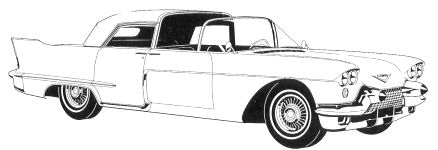
Left: line drawing by Bob Eng - Self Starter annual, 1998
Right: this artist's view appeared on an ad for a special showing of this and other 1956 GM models
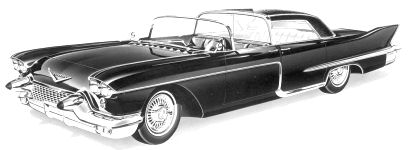
B&W and color artist's rendering of the show car
[ th colior version is used as the background image to this page ]
Reproduced in extenso below is the text of one news release [# O'Hp 4 11056, i.e. January 10, 1956] issued by Cadillac in time for the Motorama show tour:
The Cadillac Motor Car Division will display its experimental "dream car" the Eldorado Brougham Town Car, at the 1956 GM Motorama which opens at Los Angeles' Pan-Pacific Auditorium on March 3 [1956].The distinctive chauffeur-driven motor car is a companion model to the highly customized Eldorado Brougham Sedan which is scheduled for limited production later this year.
Combining contemporary design with the outstanding characteristics of the classic town car, the fiber glass experimental model personifies the modern trend in luxury motoring. Its perfectly proportioned exterior presents a low graceful silhouette of shining black ebony, set off by slim chrome window frames, roof headers and pillar facings.
The car's extremely low overall height is accented by the smoothness of the fender lines and characteristic Cadillac tail fins.
A sharply defined integral molding flowing rearward from the forward edge of the front fender to a vertical sash on the rear edge of the front door panel trims an otherwise unbroken expanse of side panelling. A cowl-wide air-intake located beneath the forward edge of the windshield provides fresh air for the rear compartment ventilating, heating and air-conditioning equipment.
Aircraft-styled engine compartment auxiliary air vents are recessed in the top of each front fender.
Dramatically styled rear quarter panels feature swept-back tail fin styling with delicately formed tapered chrome fairings extending from the center of the rear door to the integral rear bumper section. Sparkling chrome wheels are of turbine-blade design.
The clean front end lines of the special car are exemplified by the smooth contour of the exceptionally low hood design. A forward sloping cellular grille is nestled between projectile shaped "gull" bumpers beneath which are locate recessed rectangular fog lamps.
The use of separate protective chrome bumper units at the rear of the car mounted flush with the body and integrated with the structural members of the chassis maintains the unbroken curve of the rear deck which sweeps down to the bottom of the body. The bumper units form housings for the dual oval exhaust ports beneath each tail fin. The inner sections of the bumpers contain back-up lights and combination directional and stop signals. Highly visable [sic] tail lights are recessed in the vertical trailing edges of the tail fin assemblies.
Through the use of entirely new methods of construction which include an all-new frame design, all outside dimensions have been reduced without sacrificing passenger or driver comfort. The external dimensions are:
Length 219.9" Height 55.5"
Width 78.8" Wheelbase 129.5"
Traditional polished black landau leather covers the passenger compartment roof and black grain leather cowling surrounds the open chauffeur's cockpit. Two individual bucket seats with tension-spring supported cushions covered in a soft black Morocco leather of button and biscuit design are neatly molded into the partition bulkhead.
|
Chrome instrument panel inserts and instrument nacelles form a sharp contrast against the black leather and smooth painted areas of the panel. A black plastic leather-grip steering wheel with chrome spokes and a silver edged center crest complete the instrument panel impression.
A chauffeur's protection cover of pattern design leather slides on two attaching rails and is stored in the trunk when not is use. The seat dividing panel contains an intercommunication phone at the chauffeur's right hand.
The rear compartment is luxuriously trimmed in black and beige. Rear compartment doors are deeply cowled in black leather. Beige broadcloth upholstery in a biscuit and button design blends tastefully with the deep-pile beige carpeting and beige broadcloth headlining.
Gold hardware is used throughout the rear compartment which contains such comfort and convenience items as a radio-telephone combination, air-conditioning equipment, a woman's vanity compartment, a cigar humidor, a thermos bottle and glasses. Two accordion storage pockets with concealed fasteners are located on the lower partition wall."
As you can see, the English "speaked" and "writed" by the Cadillac copy writer responsible for the preceding text leaves something to be desired. Fortunately, someone came along and improved on the style and spelling in a subsequent promotional piece:
Combining contemporary design with the outstanding characteristics of the classic town car, the experimental model personifies the modern trend in luxury motoring.
The perfect proportions of the exterior presents a low graceful silhouette of shining black ebony, set off by slim chrome window frames, roof headers and pillar facings.
The car is extremely low and this is accentuated by the smoothness of the fender lines and the characteristic Cadillac tail fins.
The integral molding flowing rear-ward from the forward edge of the front fender to a vertical "sash" on the rear edge of the front door panel trims an otherwise unbroken expanse of side panelling.
The air-intake, as wide as the cowl, located beneath the forward edge of the windshield, provides fresh air for passengers in the rear compartment as well as for the heating and air-conditioning equipment.
Auxiliary air vents crafted after those used in aviation are recessed in the top of each front fender and bring additional cooling to the engine compartment.
Rear quarter panels feature swept-back tail fin styling.
Chrome fairings extend from the center of the rear door to the integral rear bumper section.
Wheels are the Kelsey-Hayes turbine-blade design in sparkling chrome. The particular shape of the spokes has earned them the designation of "sabre-spoke" when the cast wheels appeared first on the Cadillac Eldorado convertible in 1955.
The clean front end of the car, unchanged from the Eldorado Brougham sedan, is enhanced by the smooth contour of the exceptionally low hood. The forward-sloping cellular "egg-crate" grille is nestled between "bullet"-shaped "gull-wing" bumpers.
Beneath the outer edges of the bumpers are located rectangular, recessed fog lamps.
The Town Car uses separate protective chrome bumper units at the rear. Mounted flush with the body and integrated with structural members of the chassis, the curve of the rear deck remains unbroken all the way to the bottom of the body.
Beneath each tail-fin are oval ports through which extend the exhaust pipes.
The inner sections of the rear bumper units contained the reversing lights and combined directional and stop lights. Tail-lights and parking are recessed in the vertical trailing edges of the tail-fins.
New methods of construction, including an all-new frame design, make it possible to reduce all the outer dimensions of the Town Car without sacrificing passenger [or driver] comfort.
The external dimensions are : [see preceding text]
Contrary to the Eldorado Brougham sedan, traditionally crafted in steel, the Town Car body is shaped entirely in fiberglass.
The roof of the passenger compartment of the Town Car has a covering of traditional polished black "landau" leather. The chauffeur's compartment is surrounded by black grain leather.
In the front [chauffeur] compartment, two individual bucket seats with tension-spring supported cushions, covered in a soft black Morocco leather, are molded into the partition bulkhead. No lateral adjustment is possible.
The black leather and smooth black-painted areas of the instrument panel are brilliantly offset by chromium instrument inserts and instrument nacelles. The traditional Cadillac "crest", with a silver edge, is visible in the center of the steering wheel, a leather-grip affair with chromium spokes.
A pattern-design leather cover to protect the chauffeur's compartment is stored in the trunk compartment. In inclement weather it slides on two attaching side rails.
On the dividing panel between the individual front seats is located a intercom telephone handset to permit communications with passengers in the rear compartment.
That compartment is luxuriously trimmed in black and beige. The inner doors are deeply cowled in black leather while beige broadcloth in a "biscuit & button" design covers the rear seat. It blends tastefully with the deep-pile beige carpeting and beige broadcloth headlining.
Gold-coloured hardware is used throughout the rear compartment.
Mounted in the partition behind the front seat are the so-called "comfort and convenience" items. These include the radio-telephone unit to communicate with the chauffeur, air-conditioning, a vanity compartment, a cigar humidor, a thermos bottle and accompanying glasses.
On the lower part of the partition wall are two accordeon-type storage pockets for books and magazines.
The equipment stored in the partition between the chauffeur and passenger compartment prevents the use of the standard, vertically operated electric division glass. Instead, a horizontal sliding partition is used.
The door handles on this exceptional "dream car" incorporate tiny micro-switches allowing the doors to be opened effortlessly. For safety, the switches are designed so that they will not be energized when the car is in motion, thus preventing the doors from being opened accidentally.
Turning the key in one of the locks automatically locks the other three doors and cause all windows to raise to the fully closed position.
Upon cursory examination it might appear that from the windshield forward, the Eldorado Brougham Town Car and Sedan were identical. This is not so.
Besides the fact that the Town Car body was all fiberglass, the front bumper assembly too was hand-formed sheet metal, and not cast metal as in the sedan. Contrary to the sedan also, the Town Car did not have air suspension. Also, while it looked slightly more "bulky" than the sedan, the difference was a mere 4 inches in length and one half inch in height.
|
The photo at top left of the preceding "box" was followed by this descriptive text:
Cadillac's 1956 experimental "dream car" is a combination of futuristic design with the outstanding characteristics of the classic town car. Consequently, it is apporopriately called the Eldorado Brougham Town Car. The car is 78.8 inches wide, 55.8 inches high, 219.9 inches long and has a wheelbase of 129.5 inches. The tread is 61 inches both front and trear. The car's horsepower is yet to be announced.
The top exterior is of black landau leather. The lower half of the car is painted black. The construction is of fiber glass. The interior of the front compartment is decorated in black Morocco leather with black fiber glass paneling. The rear compartment is decorated all in beige with leather partition doors and quarter hangers and broadcloth seatback cushions and facings. A beige carpet is on the floor. The passenger compartment of the Eldorado Brougham Town Car contains such items as a radio-telephone combintion, air-conditioning equipment, a woman's vanity compartment, cigar hunidor and thermos bottle and glasses. The chrome [the hardware?] in the rear passenger compartment is of satin gold.
A unique safety feature designed into the Cadillac experimental car is an electronic locking system for the doors. A tiny microswitch located in each of the door handles, when depressed, electrically opens the door. When the car's automatic transmission lever is in the drive position the doors are electrically locked and cannot be opened from the outside. A safety button beneath the driver's seat releases when he leaves the car to prevent any possibility of being locked out. Another feature of the electrically locking system makes it possible to lock all doors of the car and raise all windows simply by inserting the key in either of the two rear door locks.
Although there was speculation among auto critics of the period that the Eldorado Brougham Town Car might go into limited production, the matter was not given much serious consideration at Cadillac, despite the fact that the Town Car attracted great public attention during and after the 1956 Motorama tour and the Paris Salon.
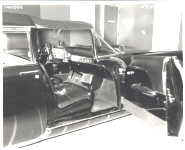
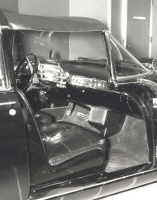
Left: Factory photo #15309, by Madler, dated 12/17/56; [details] center and right
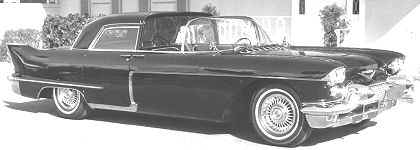

These publicity shots were taken in Miami, during the Motorama show in that city
[ Photos: © 1956, GM/Cadillac ]

On display (RH photo) with other GM "Dream Cars" of the year 1956
In fact, the Eldorado Brougham Town Car was built strictly for show. Like the Eldorado Brougham prototype for 1956 it was non-functional (i.e. no engine or major mechanical and electrical components were installed in the car). In addition, this dream car did not have the problematic air suspension. Correction [Feb. 2006]: According to enthusiast David Temple, who is preparing a book on the GM Motoramas, the Eldorado Brougham Town Car DID originally have a drive train installed. Chuck Jordan, the former VP of Design at GM told David that he [Chuck] had the power plant removed just before the car was sent out to be scrapped. The drive train was, according to Chuck, a standard Series 62 365ci coupled to a Hydra-Matic transmission; that unit apparently was donated to an area high school.
However, the car did NOT run. There was no ignition system installed, the fuel tank was fake and there was no braking system other than an emergency brake. David added: For RM to make the car run, they had to install another drive train, a fuel tank, functional brakes, and of course a wiring harness for the ignition system. If I owned the car I would have done the same thing for practical reasons. The car should not be driven, of course, as the body really is not built for such, not to mention the ever present hazard of an accident. But just to be able to move the car easily, the modifications make sense to me.
I have to disagree with David. I find it senseless to install a drive-train in a car NOT BUILT NOR EVER INTENDED TO BE DRIVEN. This is a potentially grave accident waiting to happen. As for moving the car around a Museum or showroom floor, this may be easily achieved with 4-wheel dollies. For trips further afield, I would put this baby in a special trailer rather than attempt or risk driving it on the open road.
A convertible Eldorado Brougham ?
|
Whatever happened to the town car?
In relating the story of this car, Cy Strickler, former President of the former Brougham Owners Association (BOA) said [in Milstone Car (MC), Autumn 1974] only one was built, and it no longer exists. In another article Cy wrote, what a pity that such a magnificent automobile should disappear forever. He added, however, as though he had a premonition, but who knows, maybe someday, somewhere... In an article on the Eldorado Brougham, which Cy co-authored in Car Collector, in March 1978, he added: As was its custom, GM sent the Town Car to be destroyed several years later, but a persistent rumor places its dilapidated remains in a secluded Detroit scrap yard.
Well, Cy's premonition - and the persistent rumor he mentioned turned out to be totally founded. The 1956 Eldorado Brougham Town Car, which was effectively tabled for destruction - as were most dream cars and show cars after the Motorama - miraculously survived [look at the photos at the end of this section to appreciate the work that went in to restoring this car!]
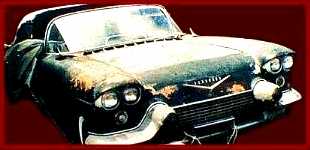
...and here it is
Since the early seventies a small group of enthusiasts has been aware that the Town Car [and a few other unique Motorama models] had been saved from destruction. The unique car had been carefully set aside by a far-sighted employee of the Warhoops breakers' yard in Detroit, near GM's Technical Center, the outfit commissioned by the auto giant to scrap the "dream cars" when they had completed the Motorama circuit.
Many attempts to purchase the Motorama survivors from the yard failed. Then, in the late eighties, the yard’s boss agreed to sell a group of them - including the Cadillac Town Car - to Joe Bortz, a collector from Highland Park, IL. Joe is CEO of the Blue Suede Shoes entertainment group. His collection of GM dream cars is as enviable as the one maintained in the Sloan Museum in Detroit which houses, inter alia, the Buick-based Y-Job and Le Sabre, GM’s Firebird and a greatly-modified Cadillac Cyclone of 1959.
Joe subsequently sold the Town Car to Roy Warshawsky of the J.C. Whitney organization. When Roy suffered a stroke, the car was later sold at auction and acquired by collector, Dick Baruk in Michigan.
|
News of the rare Town Car find was reported again in the Self Starter, monthly magazine of the Cadillac-LaSalle Club, Inc., in June 1991. Roy had entrusted its restoration to the Fran Roxas shops in Alsip, Illinois, near Chicago. He wanted to make the Town Car a drivable vehicle, although it had been intended only as a "pushmobile" show car. A 1956 Cadillac engine and transmission were found [initially, the Town Car had none]; a Brougham serial number (CB) was in fact stamped on the transmission.
Some restoration work was carried out by Fran Roxas between 1991 and 1994; it included replacing all the wood in the car and having new rear bumperettes made by a company in California (the originals were hand-formed and welded in steel and were badly rusted from decades of exposure in the breaker's yard). The roof structure also was fully restored with new wood. This initial work is reported to have cost around $50,000.
Sadly, however, Roy suffered a bad stroke and had to interrupt the restoration. The car was returned to the J.C. Whitney warehouses in the mid-nineties.
In August 1996 this writer saw the Town Car advertised for sale, on the Internet, by the well-known auctioneer, Dean Kruse and associates. It was at the Kruse auction that BOA member Dick Baruk first saw it. Another BOA member, Larry Muckey, who had been tailing the town car for some time, convinced Dick to buy it.
A short report on the finding of the town car appeared also in Auto Week for January 8, 1889 (front cover and pp. 22-25); it was combined with an article on the GM dream cars.
Restoration is completed
With guidance from Larry and others familiar with the car's many original features, Dick completed (in the strictest secrecy) the "labor of love", begun by Roy Warshawsky some two years earlier. Larry reports that the town car is fully and perfectly restored to its former, original beauty. All the amenities are there, including the gold-plated hardware in the rear compartment.
From the photos Dick and Larry were kind enough to send me during and after completion of the restoration, the car is as beautiful today as it was when first shown at the Paris auto show in late 1955. It is SUPERB! Now the whole world may admire again this Brougham for the Brass ...that the "brass" at GM had ordered to be destroyed over forty years ago but that miraculously survived.
The photos below are reproduced here by the kind courtesy of the car's owner, Dick Baruk; they are © 1998 and 1999 by Dick Baruk and Larry Muckey. Larry has been closely associated with the restoration of this car. He knows its full history better than anyone.
|
Write-Up in Car Collector magazine
Check out the February 2000 issue of Car Collector; on pp. 34-39 there is a good article on this car that includes a number of the preceding photos.
|
LATE EXTRA (April, 2003)
The Eldorado Brougham Town Car show model was offered for sale by auction on e-Bay and apparently has found a new home. If I find out its new location, and with the new owner's permission, I will add it here in due course.
LATER STILL (November, 2005)
This message was left in the Guest Book of The (new) Cadillac Database© on November 5, 2005 :
2216 Date: 2005-11-04 16:24:34
Nico Leenders ( nleenders@rmauctions.com / http://www.rmauctions.com) wrote:
RM Auctions is selling the 56 Eldorado Brougham Experimental Town car at our upcoming auction held at the Biltmore Hotel in Arizona January 20, see our Web page for further details. The car will be sold with a proper drive train, and is in exceptional condition overall.
AND EVEN LATER THAN THAT (December, 2005)
It seems the "car" won't be sold in Arizona in January, 2006 after all, but in Florida, the following month. Indeed it will be offered for sale in Boca raton by RM auctioneers. The auction catalog describes it thus: This one of a kind, fully restored 1956 Eldorado Brougham Experimental Motorama Town Car represents the pinnacle of 1950's design, elegance and luxury. The star of the 1956 GM Motorama, GM Styling Experimental Model #XP-48, was also exhibited in Paris where it displayed American decadence of the era. The interior is beautifully trimmed with black Moroccan leather in the chauffeur’s compartment and beige broadcloth in the passenger’s compartment following a 'biscuit and button' design that is complemented by an abundance of gold hardware. Ordered to be destroyed by Cadillac following its exhibition, the employees of the wrecking yard simply did not have the heart to crush such a beautiful car and tucked it away in a hidden corner of the junkyard to be forgotten. Discovered in the wrecking yard in the 1980's, this miraculous find was given a complete restoration. Now returned to its original show quality this Eldorado Brougham Experimental Town Car offers bidders an opportunity to own a unique and irreplaceable piece of automotive history [there is no indication if the "car" is still a pushmobile, i.e. a shell with no engine or transmission - according to Mr. Leenders, who wrote in November 2005, the car was to be sold in January 2006, with a proper drive train].
LATEST [Feb. 2006]
Apparently the car sold at the RM auction in Boca Raton for .....$781,100 !!! Thanks, Jerry Jansson, for sending the auction results. I understand from Eldorado Brougham owner and enthusiast, Charles Barnette [#590] that the RM people "restored" the car one step further than had Dick Baruk, by installing a Cadillac engine and transmission and (I guess) an authentic wired-and-working instrument panel as well as an adequate braking system. Charles has it from a reliable source that the EB Town Car DID have an engine and transmission mounted when they built the car, in 1956; however, it was not connected up to any instruments or gauges on the dash. One has to wonder why GM/Cadillac would go to the trouble and expense of adding an engine and transmission while leaving the fake, unwired instrument panel (made of wood) and its dummy instrument. Could it be simply to get the cars's "weight distribution" right. It certainly was not sitting right when it was found in the Warhoops yard near Chicago (photos on these pages).
The buyer, the lawyer John O'Quinn, certainly had a bob or two, since he spent (almost) a million US dollars at the RM auction, for this car as well as for 1958 Eldorado Brougham #484 (for which he paid almost $178K). These new record prices are going to make some Brougham owners very, VERY happy! Soon, I guess, nice original Broughams or perfectly restored ones will be fetching the same kind of prices as first and second generation V16s did in the late eighties and early nineties. Rare Cadillacs are becoming expensive ...and so they should.
|
Feb. 2006 - SOLD !
[ complete with engine... ]
[ Photo: courtesy Dick Baruk and Charles Barnette ]
VERY LATEST [Feb. 2006]
Sadly, the new owner was killed in a traffic accident in his native Houston, TX. A decision has been taken to sell the 800+ cars that are part of his estate. The Eldorado Brougham Town Car is being offered for sale at Amelia Island in the Spring of 2011. Will it break a new record?
Return to The (New) Cadillac Database© Index Page
or select preferred chapter
© 1996, Yann Saunders and the Cadillac-LaSalle Club, Inc.
[ Background image: Artist's view of the 1956 Eldorado Brougham Town Car ]